Spatio-Temporal Evolution and Influencing Factors of Green Development in the Yellow River Basin of China
Abstract
1. Introduction
2. Study Areas and Data Methods
2.1. Overview of the Study Area
2.2. Construction of the Evaluation Index System
2.3. Assessment of GD
2.3.1. Entropy Method (EM)
- (1)
- Construction of the global evaluation matrix: The evaluation object involves cities, the time span is periods, and the number of indicators is . The indicator data of years are combined into a global evaluation matrix, which is written as
- (2)
- Standardization of indicators: The indicators of the global evaluation matrix are standardized, where represents the item indicators of the row and column:where is the standardized index value, and and represent the maximum and minimum values of the j-th index, respectively.
- (3)
- Calculation of the percentage of each indicator:
- (4)
- Calculation of the information entropy value of the j-th indicator:where . If , then we define .
- (5)
- Calculation of the coefficient of variation of the j-th indicator :
- (6)
- Calculation of the indicator weights :
- (7)
- Calculation of the comprehensive evaluation index of GD in the YRB for each year:
2.3.2. Standard Deviation Ellipse (SDE)
2.3.3. Exploratory Spatial Data Analysis (ESDA)
2.3.4. Spatial Econometric Model
2.4. Data Source and Processing
3. Spatial and Temporal Evolution Characteristics of GD in the YRB
3.1. Temporal Evolution Characteristics of GD in the YRB
3.2. Spatial Features of GD in the YRB
3.2.1. Spatial Distribution Characteristics of GD in the YRB
3.2.2. Spatial Evolution Characteristics of GD in the YRB
3.2.3. Spatial Autocorrelation Analysis of GD in the YRB
4. Analysis of the Influencing Factors of GD in the YRB
4.1. Selection of the Influencing Factors of GD in the YRB
4.2. Model Suitability Check
4.3. Analysis of the Results
5. Discussions
5.1. Discussion of the Specificities and Generality of the YRB
5.2. Discussion on GD in the YRB
6. Conclusions and Policy Implications
6.1. Conclusions
- (1)
- The overall GD of the YRB showed an increasing trend from 2006 to 2018, but the level was low. Additionally, GD is still mainly oriented by the government and economy, while environmental improvement and life changes are relatively slow. The hierarchical characteristics of GD are prominent, showing the pattern of “upstream area > downstream area > midstream area”.
- (2)
- From the perspective of the spatial distribution characteristics, the spatial differentiation of GD in the YRB was obvious, showing a distribution structure with “quad-core pieces”, which reflected the cumulative causal effect of GD space in the YRB, which increased the degree of uneven development between regions. In terms of the spatial evolution characteristics, the center of gravity of GD in the YRB shifted to the southeast, and the locational distribution was stable in the “northwest–southeast” direction. The change in the long and short axes of the ellipse showed that the YRB’s GD showed a trend of gradual accumulation in the “northeast–southwest” direction, while it tended to diffuse and then accumulate in the “northwest–southeast” direction. At the same time, the YRB’s GD had a significant positive correlation, and the degree of spatial correlation tended to increase.
- (3)
- The spillover effect on GD in the YRB is obvious. The direct effects of ED, ST, and Open and the indirect effects of Urb and ST were positive; however, IS had a significant negative direct effect, and it is urgent to change the backward IS in the YRB.
6.2. Policy Implications
- (1)
- For the upstream areas in the YRB, the “Hulunbeier–Baotou–Erdos” GD growth pole in Inner Mongolia has taken initial shape, and it can provide a reference experience for other regions. The GD of cities along the Yellow River in Ningxia Province should take Yinchuan as the core and Shizuishan, Wuzhong, and Zhongwei as the pivot points in order to enhance the radiation-driven effect by linking and upgrading infrastructure, jointly managing the ecological environment, undertaking industries in the eastern region, etc. Meanwhile, the transportation hub function and city primacy of Yinchuan should be enhanced to realize the linkages of urban clusters along the Yellow River in Ningxia with Inner Mongolia, Shanxi, and Gansu. Gansu and Qinghai provinces should take Lanzhou and Xining as their core to enhance GD with their neighbors by building green transportation networks, developing new industries, etc. Meanwhile, they should expand by opening up to the West and strengthening ties with Eurasia to narrow the regional gap through cooperation.
- (2)
- For the midstream areas in the YRB, the ecological fragility of the Loess Plateau region cannot be ignored, and government policy is a powerful means of changing ecological problems. First, we must increase the implementation of the policy of turning farmland back into forests, improve post-maintenance work, and improve the ecological compensation mechanism to reduce soil erosion; second, we must also strengthen the supervision of polluting enterprises and implement more stringent standards for controlling pollution emissions. Energy cities in the midstream region can perform the effective green mining of fossil energy, promote changes in coal-mining methods, and build a diversified clean energy supply system; at the same time, they ought to hasten the destruction of the outdated production capacity, bolster the green transformation of established businesses, and hasten the development of new, critical industries.
- (3)
- For the downstream areas in the YRB, Zhengzhou’s GD presents H-L clustering, and Zhengzhou’s radiation role needs to be strengthened. Zhengzhou should improve its urban functions, use its transportation and geopolitical advantages, and form green industry clusters in cities in the Central Plains through regional cooperation; Henan Province should also consolidate the status of Luoyang as a sub-center city and play a supporting role. The Shandong Peninsula city cluster should accelerate the green transformation of the economy, vigorously develop the green economy, and continue to play a significant role in driving the YRB towards GD.
Author Contributions
Funding
Institutional Review Board Statement
Informed Consent Statement
Data Availability Statement
Conflicts of Interest
References
- Rao, S.; Teixeira, S. The Green New Deal: Social Work’s Role in Environmental Justice Policy. Soc. Work 2020, 65, 197–200. [Google Scholar] [CrossRef] [PubMed]
- Eckert, E.; Kovalevska, O. Sustainability in the European Union: Analyzing the Discourse of the European Green Deal. J. Risk Financ. Manag. 2021, 14, 80. [Google Scholar] [CrossRef]
- Shi, X.J. Inequality of opportunity in energy consumption in China. Energy Policy 2019, 124, 371–382. [Google Scholar] [CrossRef]
- bp Statistical Review of World Energy 2020. Available online: https://www.bp.com/content/dam/bp/business-sites/en/global/corporate/pdfs/energy-economics/statistical-review/bp-stats-review-2020-full-report.pdf (accessed on 31 May 2022).
- Sun, C.Z.; Tong, Y.L.; Zou, W. The evolution and a temporal-spatial difference analysis of green development in China. Sustain. Cities Soc. 2018, 41, 52–61. [Google Scholar] [CrossRef]
- Wang, M.X.; Zhao, H.H.; Cui, J.X.; Fan, D.; Lv, B.; Wang, G.; Li, Z.H.; Zhou, G.J. Evaluating green development level of nine cities within the Pearl River Delta, China. J. Clean. Prod. 2018, 174, 315–323. [Google Scholar] [CrossRef]
- Ye, T.F.; Xiang, X.L.; Ge, X.Y.; Yang, K.L. Research on Green Finance and Green Development Based Eco-Efficiency and Spatial Econometric Analysis. Sustainability 2022, 14, 2825. [Google Scholar] [CrossRef]
- Zeng, T.; Wu, Z.L. Research progress and analysis of international green development. Environ. Sustain. Dev. 2020, 45, 5–15. [Google Scholar]
- Li, Z.R.; Zheng, K.H.; Zhong, Q.K. Comprehensive Evaluation and Spatial-Temporal Pattern of Green Development in Hunan Province, China. Sustainability 2022, 14, 6819. [Google Scholar] [CrossRef]
- Zhang, X.; Wei, F.L.; Yuan, X.M. Evaluation and evolution of provincial high-quality green development in China. Econ. Geogr. 2020, 40, 108–116. [Google Scholar]
- Pearce, D.; Markandya, A.; Barbier, E. Blueprint for a Green Economy; Earthscan: London, UK, 1989. [Google Scholar]
- Zhu, B.Z.; Zhang, M.F.; Zhou, Y.H.; Wang, P.; Sheng, J.C.; He, K.J.; Wei, Y.M.; Xie, R. Exploring the effect of industrial structure adjustment on interprovincial green development efficiency in China: A novel integrated approach. Energy Policy 2019, 134, 110946. [Google Scholar] [CrossRef]
- Fan, W.G.; Zhang, P.Y.; Tong, L.J.; Li, C.G.; Li, X.; Li, J.; Ma, Z.P. Green Development for Supporting Sustainability of Northeast China: Performance Quantification, Spatio-temporal Dynamics and Implications. Chin. Geogr. Sci. 2022, 32, 467–479. [Google Scholar] [CrossRef]
- Li, L.; Lei, Y.L.; Pan, D.Y.; Si, C.Y. Research on Sustainable Development of Resource-Based Cities Based on the DEA Approach: A Case Study of Jiaozuo, China. Math. Probl. Eng. 2016, 2016, 5024837. [Google Scholar] [CrossRef]
- Halkos, G.; Tzeremes, N.; Kourtzidis, S. Measuring Sustainability Efficiency Using a Two-Stage Data Envelopment Analysis Approach. J. Ind. Ecol. 2016, 20, 1159–1175. [Google Scholar] [CrossRef]
- Li, G.; Zhou, Y.; Liu, F.; Wang, T. Regional Differences of Manufacturing Green Development Efficiency Considering Undesirable Outputs in the Yangtze River Economic Belt Based on Super-SBM and WSR System Methodology. Front. Environ. Sci. 2021, 8, 631911. [Google Scholar] [CrossRef]
- Zhou, L.; Che, L.; Zhou, C.H. Spatio-temporal evolution and influencing factors of urban green development efficiency in China. Acta Geogr. Sin. 2019, 74, 2027–2044. [Google Scholar] [CrossRef]
- Li, Y.; Chen, Y.Y.; Li, Q. Assessment analysis of green development level based on S-type cloud model of Beijing-Tianjin-Hebei, China. Renew. Sustain. Energy Rev. 2020, 133, 110245. [Google Scholar] [CrossRef]
- Huang, M.X.; Li, S.Y. The analysis of the impact of the Belt and Road initiative on the green development of participating countries. Sci. Total Environ. 2020, 722, 137869. [Google Scholar] [CrossRef]
- Li, C.; Song, L.R. Regional Differences and Spatial Convergence of Green Development in China. Sustainability 2022, 14, 8511. [Google Scholar] [CrossRef]
- Zhang, Z.Y.; Hu, Z.N.; Zhong, F.L.; Cheng, Q.P.; Wu, M.Z. Spatio-Temporal Evolution and Influencing Factors of High Quality Development in the Yunnan & Guizhou, Region Based on the Perspective of a Beautiful China and SDGs. Land 2022, 11, 821. [Google Scholar]
- Qiu, F.D.; Chen, Y.; Tan, J.T.; Liu, J.B.; Zheng, Z.Y.; Zhang, X.L. Spatial-temporal Heterogeneity of Green Development Efficiency and Its Influencing Factors in Growing Metropolitan Area: A Case Study for the Xuzhou Metropolitan Area. Chin. Geogr. Sci. 2020, 30, 352–365. [Google Scholar] [CrossRef]
- Zhuo, C.F.; Xie, Y.P.; Mao, Y.H.; Chen, P.Q.; Li, Y.Q. Can cross-regional environmental protection promote urban green development: Zero-sum game or win-win choice? Energy Econ. 2022, 106, 105803. [Google Scholar] [CrossRef]
- Yang, L.S.; Ni, M.Y. Is financial development beneficial to improve the efficiency of green development? Evidence from the “Belt and Road” countries. Energy Econ. 2022, 105, 105734. [Google Scholar] [CrossRef]
- Qian, Z.M.; Liu, X.C. Regional differences in China’s green economic efficiency and their determinants. China Popul. Resour. Environ. 2013, 23, 104–109. [Google Scholar]
- Rui, Q.; Feng, D.; Long, A.T. Evaluation of green development level in the Yellow River Basin and analysis of obstacle factors. Stat. Decis. 2021, 37, 72–76. [Google Scholar]
- Feng, C.; Wang, M.; Liu, G.C.; Huang, J.B. Green development performance and its influencing factors: A global perspective. J. Clean. Prod. 2017, 144, 323–333. [Google Scholar] [CrossRef]
- Liu, N. Research on Xi Jinping’s important exposition on green lifestyle. J. Nanjing Univ. Technol. (Soc. Sci. Ed.) 2021, 20, 40–48. [Google Scholar]
- Zhang, H.; Geng, Z.R.; Yin, R.S.; Zhang, W. Regional differences and convergence tendency of green development competitiveness in China. J. Clean. Prod. 2020, 254, 119922. [Google Scholar] [CrossRef]
- Shu, C.; Zhu, P.Y.; Xu, B. Measurement of green development and its spatial differentiation in Jiangxi province. Econ. Geogr. 2021, 41, 180–186. [Google Scholar]
- Guo, F.Y.; Lv, X.; Yu, W.; Ren, J.M.; Chu, N.C. Performance evaluation and driving mechanism of green development in shandong province based on panel data of 17 cities. Geogr. Sci. 2020, 40, 200–210. [Google Scholar]
- Jiang, S.G.; Yu, H.L.; Li, Z.H.; Geng, B.; Li, T. Study on the Evolution of the Spatial-Temporal Pattern and the Influencing Mechanism of the Green Development Level of the Shandong Peninsula Urban Agglomeration. Sustainability 2022, 14, 9549. [Google Scholar] [CrossRef]
- Fang, G.C.; Wang, Q.L.; Tian, L.X. Green development of Yangtze River Delta in China under Population-Resources-Environment-Development-Satisfaction perspective. Sci. Total Environ. 2020, 727, 138710. [Google Scholar] [CrossRef]
- Liu, H.J.; Wang, Y.H.; Lei, M.Y. Spatial agglomeration of strategic emerging industries in China. Quant. Tech. Econ. Res. 2019, 36, 99–116. [Google Scholar]
- Wang, Z.B.; Liang, L.W.; Wang, X.J. Spatio-temporal evolution patterns and influencing factors of PM2.5 in Chinese urban agglomerations. Acta Geogr. Sin. 2019, 74, 2614–2630. [Google Scholar]
- Sun, X.L.; Yan, D.S. Measurement and decomposition of spatial spillover effects of economic growth in the yangtze river delta. Econ. Geogr. 2021, 41, 66–73. [Google Scholar]
- Zhang, S.Y. The construction of green development and green lifestyle. Shandong Soc. Sci. 2018, 3, 18–24. [Google Scholar]
- Lu, C.Y.; Cheng, W.; Huang, P.; Liu, X.W.; Tang, X.L. Spatio-temporal comprehensive measurement of China’s industrial green development level and associated influencing factors. Ecol. Econ. 2022, 38, 54–61+69. [Google Scholar]
- Xiong, X.; Zhang, T.; Duan, Y.J.; Fang, X.P.; Zhou, J.Y. Measurement and comparison of the level of the green development about urban agglomeration in the middle reaches of the Yangtze River. Econ. Geogr. 2019, 39, 96–102. [Google Scholar]
- Che, L.; Bai, Y.P.; Zhou, L.; Wang, F.; Ji, X.P.; Qiao, F.W. Spatial pattern and spillover effects of green development efficiency in China. Sci. Geogr. Sin. 2018, 38, 1788–1798. [Google Scholar]
- LeSage, J.P.; Pace, R.K. Introduction to Spatial Econometrics; CRC Press: Boca Raton, FL, USA, 2009. [Google Scholar]
- Zhang, R.J.; Dang, H.Z. Measurement of the green development level of cities in the Yangtze River Economic Belt Structural analysis associated with space. Stat. Decis. 2022, 38, 118–123. [Google Scholar]
- Ren, B.P. The Yellow River Basin Ecological Protection and High-quality Development Innovation-driven Strategy and its realization path. Ningxia Soc. Sci. 2022, 3, 131–138. [Google Scholar]
- Shi, W.J.; Wu, Y.Y.; Sun, X.; Gu, X.Y.; Ji, R.; Li, M. Environmental Governance of Western Europe and Its Enlightenment to China: In Context to Rhine Basin and the Yangtze River Basin. Bull. Environ. Contam. Toxicol. 2021, 106, 819–824. [Google Scholar] [CrossRef]
- Guo, F.Y.; Gao, S.Q.; Tong, L.J.; Ren, J.M. Spatio-temporal evolution track and influencing factors of green development efficiency in Yellow River Basin. Geogr. Res. 2022, 41, 167–180. [Google Scholar]
- Ji, Y.Y.; Zhang, L.J.; Qin, Y.C.; Chen, J.L.; Wu, S.J. The impact of “four modernizations” on green development in Chinese prefecture-level cities: A spatial econometric analysis. Econ. Geogr. 2020, 40, 184–194. [Google Scholar]
- Salem, M.; Tsurusaki, N.; Divigalpitiya, P.; Osman, T.; Hamdy, O.; Kenawy, E. Assessing Progress Towards Sustainable Development in the Urban Periphery: A Case of Greater Cairo, Egypt. Int. J. Sustain. Dev. Plan. 2020, 15, 971–982. [Google Scholar] [CrossRef]
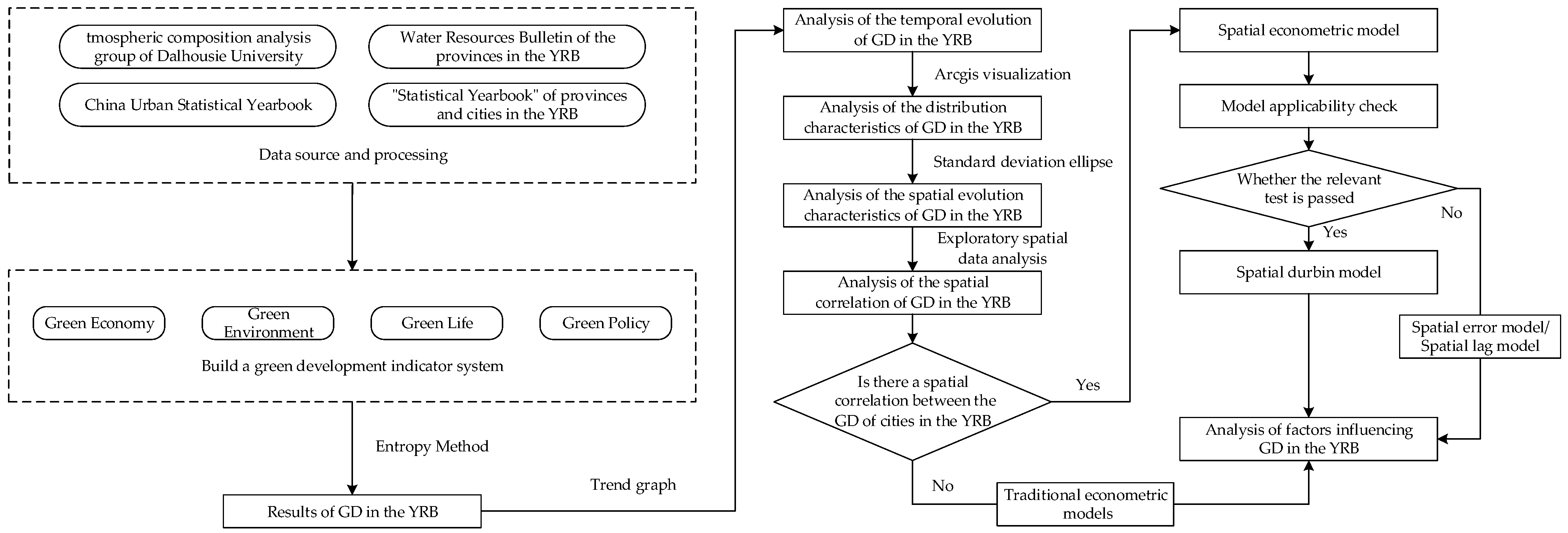
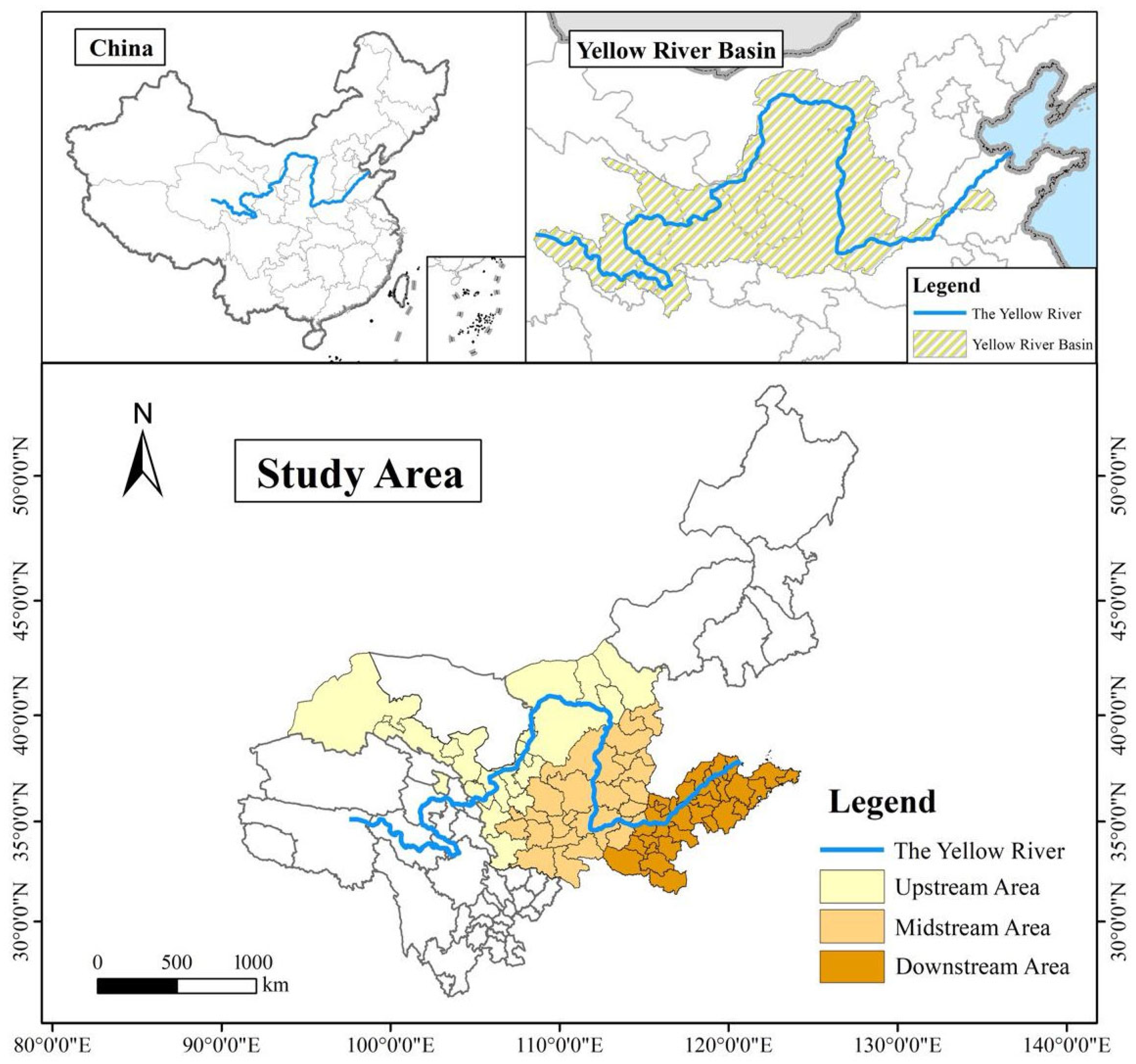
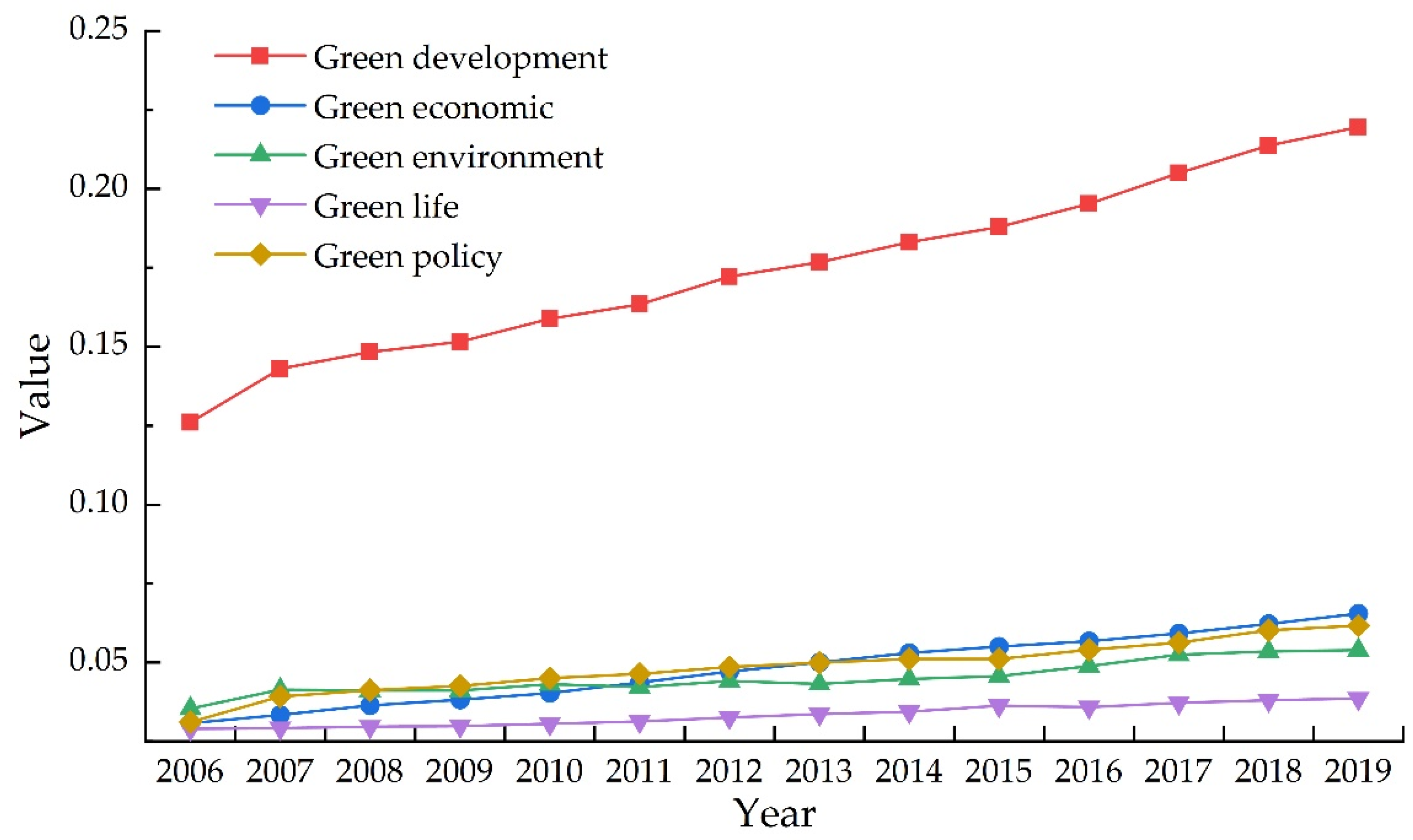

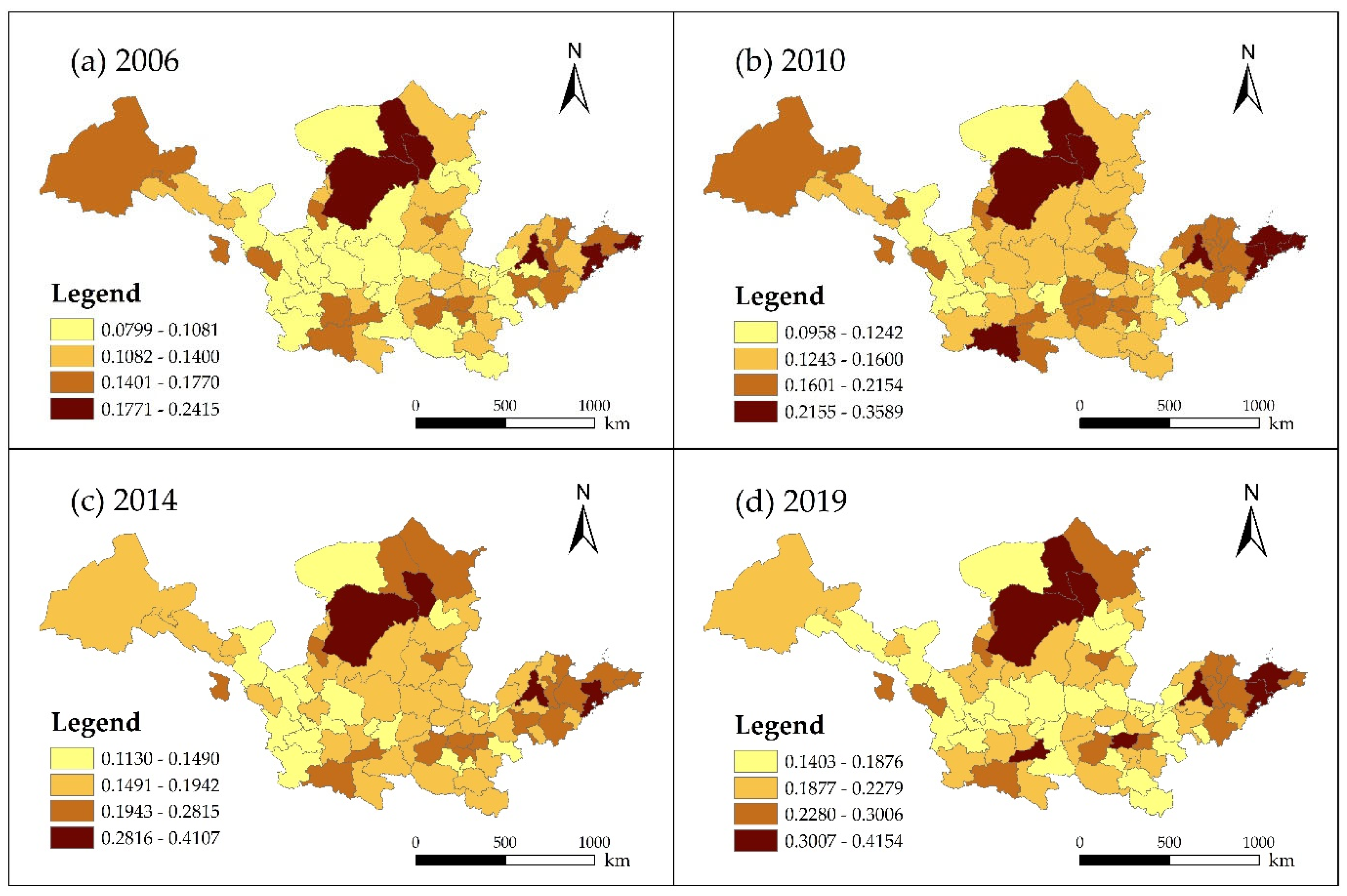

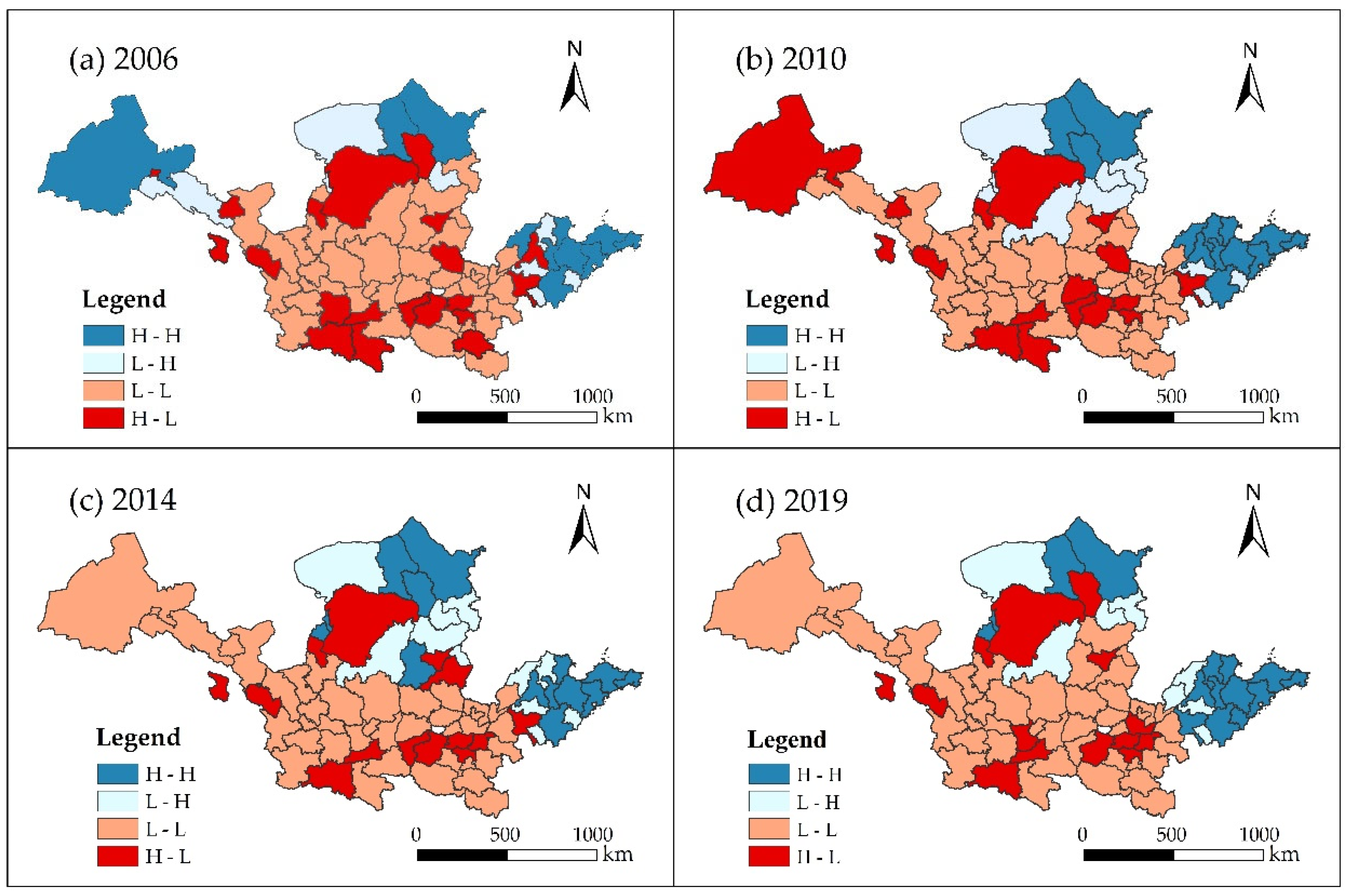
| Criterion Layer | Indicator Layer | Indicator Description | Indicator Direction | Weights | Source of Indicator |
|---|---|---|---|---|---|
| Green Economy | Material living standard | Per capita disposable income (yuan) | + | 0.0543 | [29] |
| Service level | The tertiary industry’s share of GDP (%) | + | 0.0176 | [30] | |
| Resource and environment utilization efficiency | SO2 emissions per unit of GDP (t/10,000 yuan) | + | 0.0014 | [31] | |
| Economic vitality | Total retail sales of social consumer goods per capita (yuan/person) | + | 0.0877 | [31] | |
| Green output | Wastewater discharge per unit of GDP (t/10,000 yuan) | - | 0.0015 | [32] | |
| Green Environment | Resource abundance | Water resources per capita (m3/person) | + | 0.2071 | [30] |
| Urban ecological construction level | Green coverage rate of built-up area (%) | + | 0.0104 | [32] | |
| Urban living environment | Landscape area (hectares) | + | 0.1358 | [30] | |
| Air quality | PM2.5 (µg/m3) | - | 0.0243 | [29] | |
| Environmental pressure | SO2 emissions per capita (ton/person) | - | 0.0018 | [30] | |
| Green Life | Population density | Total population/administrative area at the end of the year (person/km2) | - | 0.0061 | [33] |
| Social water supply security capacity | Water supply per capita (ton/person) | + | 0.0652 | [31] | |
| Green travel | Number of public transport vehicles per 10,000 people in the city (vehicles) | + | 0.0711 | [30] | |
| Residential energy consumption | Electricity consumption per capita in the whole society (KW·h/person) | - | 0.0018 | [30] | |
| City public service | Urban road area per capita (m2/person) | + | 0.0713 | [30] | |
| Green Policy | Industrial optimization and transformation efforts | Industrial advanced coefficient (%) | + | 0.0588 | [31] |
| Green investment | Science and technology expenditure/general public budget expenditure (%) | + | 0.1026 | [31] | |
| Market environment support | Private economic development index (%) | + | 0.0588 | [31] | |
| Pollution control | Centralized treatment rate of sewage treatment plants (%) | + | 0.0115 | [32] | |
| Urban governance | Harmless municipal waste treatment rate (%) | + | 0.0105 | [32] |
| Year | Geographic Coordinates | X-Axis Standard Deviation (km) | Y-Axis Standard Deviation (km) | Rotation (°) |
|---|---|---|---|---|
| 2005 | 111.38° E, 36.59° N | 893.18 | 429.90 | 98.80 |
| 2010 | 111.55° E, 36.55° N | 865.31 | 432.38 | 97.84 |
| 2014 | 111.58° E, 36.60° N | 857.52 | 427.01 | 98.42 |
| 2019 | 111.59° E, 36.54° N | 864.54 | 426.17 | 97.97 |
| Year | I | Z | Year | I | Z | Year | I | Z |
|---|---|---|---|---|---|---|---|---|
| 2006 | 0.036 *** | 1.298 | 2011 | 0.042 *** | 2.828 | 2016 | 0.045 *** | 2.739 |
| 2007 | 0.036 *** | 1.390 | 2012 | 0.048 *** | 2.079 | 2017 | 0.048 *** | 2.867 |
| 2008 | 0.042 *** | 1.911 | 2013 | 0.056 *** | 2.800 | 2018 | 0.044 *** | 3.024 |
| 2009 | 0.032 *** | 1.989 | 2014 | 0.045 *** | 3.129 | 2019 | 0.048 *** | 2.443 |
| 2010 | 0.039 *** | 2.099 | 2015 | 0.036 *** |
| Variable Full Name | Variable Abbreviation | Variable Description |
|---|---|---|
| Economic development | ED | Real GDP/total population at the end of the year (yuan), take the logarithm |
| Government regulation | GR | General public budget expenditure/GDP |
| Urbanization | Urb | Permanent urban population/year-end permanent population |
| Industrial structure | IS | The added value of the secondary industry as a percentage of GDP |
| Science and Technology | S&T | Technology, education spending/general public budget spending |
| Opening up to the outside world | Open | Actual utilization of foreign capital/total population at the end of the year (USD), take the logarithm |
| Testing Method | Statistics | Testing Method | Statistics |
|---|---|---|---|
| LM error | 32.725 *** | Wald–spatial error | 21.41 *** |
| Robust LM error | 43.843 *** | Wald–spatial lag | 23.18 *** |
| LM lag | 26.579 *** | LR–spatial lag | 22.93 *** |
| Robust LM lag | 37.697 *** | LR–spatial error | 31.59 *** |
| Variable | Estimated Coefficients | Spatial Lag Term Coefficient | Direct Effect Coefficient | Indirect Effect Coefficient | Total Effect Coefficient |
|---|---|---|---|---|---|
| ED | 0.0537 *** | −0.0403 ** | 0.0534 *** | −0.0258 | 0.0277 |
| (12.7900) | (−2.5639) | (12.7400) | (−0.7189) | (0.7679) | |
| GR | −0.0263 | −0.1315 | −0.0350 | −0.3666 | −0.4016 |
| (−0.5060) | (−0.6203) | (−0.7670) | (−0.6897) | (−0.7512) | |
| Urb | 0.0047 | 0.1634 ** | 0.0102 | 0.4206 ** | 0.4308 ** |
| (0.3390) | (2.1368) | (0.6785) | (2.4264) | (2.4363) | |
| IS | −0.0181 ** | 0.0177 | −0.0172 * | 0.0157 | −0.0015 |
| (−2.0778) | (0.4044) | (−1.7987) | (0.1448) | (−0.0133) | |
| S&T | 0.0359 *** | 0.0771 | 0.0362 ** | 0.2399 * | 0.2761 ** |
| (2.6684) | (1.5183) | (2.3464) | (1.7769) | (2.0460) | |
| Open | 0.0015 *** | −0.0028 | 0.0015 *** | −0.0043 | −0.0028 |
| (3.2916) | (−1.3445) | (3.4210) | (−0.7759) | (−0.5031) | |
| ρ | 0.5885 *** | ||||
| (7.3597) | |||||
| R-squared | 0.571 | 0.571 | 0.571 | 0.571 | 0.571 |
Publisher’s Note: MDPI stays neutral with regard to jurisdictional claims in published maps and institutional affiliations. |
© 2022 by the authors. Licensee MDPI, Basel, Switzerland. This article is an open access article distributed under the terms and conditions of the Creative Commons Attribution (CC BY) license (https://creativecommons.org/licenses/by/4.0/).
Share and Cite
Zhang, S.; Lv, Y.; Zhang, B. Spatio-Temporal Evolution and Influencing Factors of Green Development in the Yellow River Basin of China. Sustainability 2022, 14, 12407. https://doi.org/10.3390/su141912407
Zhang S, Lv Y, Zhang B. Spatio-Temporal Evolution and Influencing Factors of Green Development in the Yellow River Basin of China. Sustainability. 2022; 14(19):12407. https://doi.org/10.3390/su141912407
Chicago/Turabian StyleZhang, Shumin, Yongze Lv, and Baolei Zhang. 2022. "Spatio-Temporal Evolution and Influencing Factors of Green Development in the Yellow River Basin of China" Sustainability 14, no. 19: 12407. https://doi.org/10.3390/su141912407
APA StyleZhang, S., Lv, Y., & Zhang, B. (2022). Spatio-Temporal Evolution and Influencing Factors of Green Development in the Yellow River Basin of China. Sustainability, 14(19), 12407. https://doi.org/10.3390/su141912407





